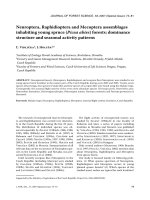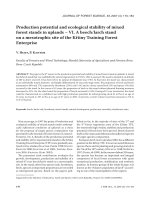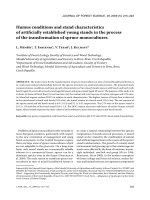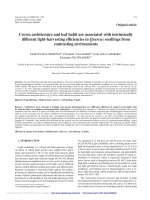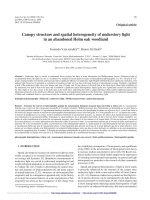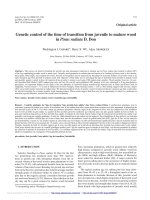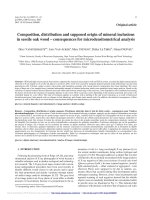Báo cáo lâm nghiệp: "Genetic variation and genotype by environment interactions of juvenile wood chemical properties in Pinus taeda " pps
Bạn đang xem bản rút gọn của tài liệu. Xem và tải ngay bản đầy đủ của tài liệu tại đây (388.32 KB, 8 trang )
Ann. For. Sci. 63 (2006) 897–904 897
c
INRA, EDP Sciences, 2006
DOI: 10.1051/forest:2006073
Original article
Genetic variation and genotype by environment interactions
of juvenile wood chemical properties in Pinus taeda L.
Robert S
a
, Bailian L
a
*
,FikretI
a
, John K
b
,H M.C
c
a
Department of Forestry and Environmental Resources, North Carolina State University, College of Natural Resources,
Raleigh, NC 27695-8002, USA
b
Forest Sciences Centre, University of British Columbia, Vancouver, BC, V6T 1Z4, Canada
c
Department of Wood and Paper Science, North Carolina State University, Raleigh, NC 27695-8005, USA
(Received 31 October 2005; accepted 13 February 2006)
Abstract – Genetic variation and genotype by environment interaction (G×E) were studied in several juvenile wood traits of 11 year-old loblolly pine
trees (Pinus taeda L.). Wafer thin (200 µm) samples from juvenile (ring 3) and transition (ring 8) wood of 12 mm increment cores were analyzed.
Transition wood had higher α-cellulose content (46.1%), longer fiber (1.98 mm), and higher coarseness (0.34), but lower lignin (29.7%) than juvenile
wood (cellulose 40.9%, fiber length 1.4 mm, coarseness 0.28 and lignin 30.3%). General combining ability variance for the traits explained 2% to 10%
of the total variance, whereas the specific combining ability variance was negligible, except for α-cellulose content in transition wood (2%). Specific
combining ability by site interaction variance explained from 5% (fiber length) to 37% (lignin) of the total variance. Weak individual-tree heritabilities
were found for all the traits, except coarseness, which was moderately high in both juvenile (0.39) and transition wood (0.30). Full-sib and half-sib
family heritabilities of traits ranged 0.29 to 0.72. Genetic correlations of wood quality traits with volume and stem straightness were weak, while
favorable genetic correlations of lignin with cellulose, coarseness and fiber length were observed. Implications on forest tree improvement programs
were discussed.
heritability / genetic correlation / α-cellulose / coarseness / lignin
Résumé – Variabilité génétique et stabilité génotype-environnement pour les propriétés chimiques du bois à un stade juvénile chez Pinus taeda
L. La variabilité génétique et la stabilité génotype-environnement (G×E) ont été étudiées pour plusieurs caractéristiques du bois juvénile de pins taeda
(Pinus taeda L.) âgés de 11 ans. De petits échantillons de bois de 2 mm d’épaisseur ont été extraits de carottes de sondage (12 mm), dans le bois
juvénile (cerne 3) et dans la zone de transition (cerne 8). Le bois de transition a une teneur en α-cellulose plus élevée, des fibres plus longues (1,98 mm)
et une grosseur de grain plus élevée (0,34) mais une teneur en lignine (29,7 %) plus faible que le bois juvénile (teneur en cellulose : 40,9 %, longueur
des fibres : 1,4 mm, grosseur du grain : 0,28 et teneur en lignine : 30,3 %). La variance des aptitudes générales à la combinaison (AGC) explique entre
2 et 10 % de la variance totale, tandis que la variance des aptitudes spécifiques à la combinaison (ASC) est négligeable, excepté pour la teneur en
α-cellulose dans la zone de transition (2 %). La variance de du terme d’interaction SCA-site explique de 5 % (longueur de fibres) à 37 % (teneur en
lignine) de la variance totale. Les héritabilités au sens strict sont faibles pour tous les caractères sauf pour la grosseur du grain. Pour ce caractère, elle est
modérément élevée dans le bois juvénile (0,39) et dans la zone de transition (0,30). Les héritabilités au niveau moyennes de familles de pleins-frèreset
de demi-frères varient de 0,29 à 0,72 pour ces caractères. Les corrélations génétiques entre propriétés du bois d’une part et le volume et la rectitude du
tronc d’autre part sont faibles ; elles sont favorables entre teneur en lignine et teneur en cellulose, grosseur du grain et longueur de fibre. Les implications
pour l’amélioration génétique de l’essence sont ensuite discutées.
héritabilité / corrélation génétique / α-cellulose / fibre / grosseur du grain / lignine
1. INTRODUCTION
Genetic improvement and intensive silviculture of loblolly
pine (Pinus taeda L.) have increased forest plantation produc-
tivity significantly in the southern United States [6]. With im-
proved growth, rotation ages have been reduced to about 20
to 25 years compared with 40 to 50 years in natural stands.
Consequently, the percent of juvenile wood from plantations
has increased [11] mainly because of faster growth and early
harvesting. Juvenile wood typically has less desirable wood
properties than mature wood, e.g., lower wood density, shorter
* Corresponding author:
tracheid length, and higher lignin content. These wood prop-
erties are associated with low pulp yield and high pulping
costs [8, 12, 14]. However, if there is large genetic variation
in these juvenile wood properties in loblolly pine, it may be
possible to improve the juvenile wood for solid and chemical
wood products through a recurrent breeding program.
Sykes et al. [14] reported large genetic variation in certain
wood properties in loblolly pine. Considerable genetic vari-
ation in α-cellulose content, average fiber length, and lignin
content have also been reported in juvenile wood for loblolly
pine and for several other tree species [1, 8, 12, 13, 18]. How-
ever, there is little information on how genotypes interact with
different environments for these same wood properties. It is
Article published by EDP Sciences and available at or />898 R. Sykes et al.
essential to determine the magnitude of genotype by environ-
ment interaction (G×E) for a tree breeding program to be ef-
fective [3,10]. The level of G×E would help tree breeders and
practical foresters decide how to effectively design breeding
programs and whether genotypes with desirable wood traits
can be planted in different environments. Such information
would benefit tree improvement programs of loblolly pine and
the pulp and paper industry by allowing the selection and
planting of suitable trees on suitable sites. If G×E is deemed
to be negligible, then selected genotypes could be used for
plantations to produce uniform wood under different environ-
mental conditions. This would increase yield, improve product
properties, and lower pulping costs [19].
The propose of this study was to determine the level of ge-
netic variation of key juvenile wood properties in loblolly pine
on four test sites and examine G×E interaction. Specific objec-
tives were (1) to compare genetic variation in α-cellulose con-
tent, fiber length, coarseness, and lignin content on four field
test sites, (2) examine G×E interaction of the same traits, and
(3) study relationships between growth, stem quality, wood
density with these additional wood traits.
2. MATERIALS AND METHODS
2.1. Materials and data collection
Fourteen full-sib families generated by a 6-parent half-diallel mat-
ing design were tested on four sites in South Carolina, in the south-
eastern USA. Sites 1 and 2 were established on a relatively fertile
soil in 1989. Sites 3 and 4 were established one year later on sandy
soils with lower fertility. The average rainfall and temperatures do not
vary between sites because of their close proximities and landscape.
A randomized complete block design with six blocks was used in
the field. Each full-sib family was laid out in 6-tree row-plots in each
block. Wood core samples were collected from every healthy (disease
free, dominant or co-dominant) tree in the row-plot when the trees
were 11-year-old. Bark to bark 12 mm increment cores were taken
from each tree at breast height (about 1.30 m above ground) using
generator-powered drills. Wood cores having visible limbs, curves,
resin pockets, or compression wood were avoided. The samples were
placed in sealed plastic storage bags and stored in coolers to retain
moisture during the material collection. At the time of wood incre-
ment collection height, diameter or stem straightness were not mea-
sured but sixth-year values of these traits were available.
In the laboratory, the bark and cambium were removed from the
wood cores, and the cores were split at the pith into two radii. Non-
volatile extractives greater than 95% were removed from increment
cores by four successive two-day acetone extractions [17]. The incre-
ment cores were then soaked in water overnight before ring wood
samples were taken. Within-core samples were taken from ring 3
and ring 8 from the pith to study chemical properties of juvenile
wood (ring 3) and transition wood (ring 8), respectively. Thin wafers
(200 µm) from earlywood and latewood of ring 3 and ring 8 were
taken using a microtome. At least 300 mg of each sample were taken
from the earlywood and latewood of each ring. Each sample was
oven-dried for 12 h [14]. Chemical analysis of α-cellulose and lignin
content, fiber length and coarseness was done using microanalytical
techniques developed by Yokoyama et al. [17], which allows the rapid
characterization of fiber components and morphology of loblolly pine
in a large number of samples. Briefly, the techniques involved are
removal of extractives, holo-cellulose preparation, α-cellulose and
lignin content determination, and average fiber length and coarseness
analyses.
2.2. Statistical analyses
Juvenile wood and transition wood were compared for micro
wood traits using the paired t-tests. A general linear mixed model was
fitted to data to estimate variance components for combined sites.
y = Xβ + Zγ + ε (1)
where, y is the vector of individual observations, β is the vector of
fixed-effects parameters (overall mean, site, and blocks within site),
γ is the vector of random-effects parameters including general com-
bining ability (GCA) for female and male, specific combining ability
(SCA), GCA by site interaction, SCA by site interaction, and plot-
to-plot error. The ε is an unknown random error vector; X and Z are
known design matrices for fixed and random effects, respectively. The
variance of the Y vector is V = V(Y) = ZGZ
T
+R [7]. The random fac-
tors (γ) and the errors (ε) are assumed to have normal distributions.
Thus, the random effects are assumed to have 0 mean and G diagonal
variance-covariance matrix. Similarly, the errors assumed to have 0
mean and R variance-covariance matrix (R = σ
2
I
n
). The diallel ge-
netic analyses were carried out using a general linear mixed model
and implementing with the SAS Mixed procedure [16]. Using vari-
ance components from the mixed model, individual-tree (h
2
i
), half-sib
family (h
2
hs
), and full-sib family (h
2
fs
) heritabilities were estimated for
the wood properties as follows:
h
2
i
=
4σ
2
g
2σ
2
g
+ σ
2
s
+ 2σ
2
gl
+ σ
2
sl
+ σ
2
plot
+ σ
2
e
(2)
h
2
hs
=
σ
2
g
pσ
2
g
+ σ
2
s
+
pσ
2
gl
t
+
σ
2
sl
t
+
σ
2
plot
tb
+
σ
2
e
tbn
1
(p−1)
(3)
h
2
fs
=
2σ
2
g
2σ
2
g
+ σ
2
s
+
2σ
2
gl
t
+
σ
2
sl
t
+
σ
2
plot
tb
+
σ
2
e
tbn
(4)
where, σ
2
g
is the GCA variance, σ
2
s
is the SCA variance, σ
2
gl
and σ
2
sl
are the GCA by site and SCA by site interactions, σ
2
plot
is the plot
variance, σ
2
e
is the residual variance, t is the number of sites (t = 4),
b is the number of blocks within sites (b = 6), p is the number of
parents (p = 6) and n is the harmonic mean number of trees within
plot (n = 2.83). Standard errors of heritabilities were estimated by the
Delta Method [9]. Individual-tree breeding values were estimated by
adding parental general combining ability estimates to the estimated
within-family value (Aw). Within-family value (Aw) for each tree is
obtained from solving the mixed model equation as y − Xβ − Zγ and
adjusting by approximate within-family heritability (2σ
2
g
/σ
2
e
).
Product-moment correlations were estimated among the wood
properties, stem straightness, and growth traits. Approximate genetic
correlations among traits were calculated using individual-tree breed-
ing values of the wood properties. Hypothesis test (H
0
: r
p
= 0, H
0
:
r
A
= 0) of phenotypic and approximate genetic correlations were car-
ried out using a t distribution with n-2 degrees of freedom. The mag-
nitudes of genotype by environment interactions were estimated by
analyzing combined sites under the general linear mixed model given
Genetic variation of wood properties 899
Figure 1. α-cellulose (%), lignin (%), fiber length (mm) and coarseness means for ring 3 and ring 8 from the pith. E and L stands for earlywood
and latewood within each ring, respectively. The thick horizontal bars in the middle of the boxes are the standard deviations.
Table I. Comparisons of juvenile (ring 3) and transition (ring 8) wood for α-cellulose (ACY), lignin (LIG), fiber length (FLW) and coarseness
(COA) of loblolly pine across four sites.
Variable Ring 3 (mean ± SE) Ring8(mean± SE)
1
DF t Va l ue
1
P > |t|
ACY (%) 40.9 ± 0.09 46.1 ± 0.12 3347 –35.7 < 0.0001
LIG (%) 30.3 ± 0.04 29.7 ± 0.04 3702 9.4 < 0.0001
FLW (mm) 1.40 ± 0.006 1.98 ± 0.012 2715 –42.5 < 0.0001
COA (ratio) 0.28 ± 0.0015 0.34 ± 0.0022 3091 –20.6 < 0.0001
1
DF is the degrees of freedom for the paired t test, P > |t| is the probability of t statistic.
in equation (1). Type B correlation (r
B_gca
) for a trait was estimated
using the additive genetic variance and genotype by environment in-
teraction variance as follows:
r
B_gca
=
σ
2
g
σ
2
g
+ σ
2
gl
. (5)
A correlation coefficient close to 1.0 indicates no interaction, whereas
small coefficients indicate significant rank changes among the geno-
types from one location to another.
3. RESULTS
Sites were significantly different for α-cellulose content
(P > 0.001) and coarseness (P < 0.01) but not for lignin con-
tent (P = 0.888) and fiber length (P < 0.582). Faster growing
sites 1 and 2 had smaller coarseness than the slower grow-
ing sites 3 and 4. There was inconsistency between the rate
of sites’ growth and α-cellulose content (data were not pre-
sented). The fastest growing site 2 located at the river bed had
significantly smaller cellulose content (41.4%) compared to
the slower growing site 4 (46.4%).
3.1. Comparison of wood types
Alpha cellulose content (%), fiber length (mm), and coarse-
ness based on across sites increased from the earlywood to
latewood within a ring (Fig. 1). In contrast, lignin content
(%) did not change. Transition wood (ring 8) had significantly
(P > 0.0001) greater percentage of α-cellulose, longer fiber,
greater coarseness, and less lignin than juvenile wood (ring 3)
(Tab. I). Transition wood had about 5.2% more α-cellulose
than juvenile wood. The difference between two wood types
for lignin content was less than 1% but still significant. Tran-
sition wood had about 0.58 mm longer fibers than juvenile
wood. We observed two distinct variation patterns for the ju-
venile and transition wood (Fig. 2). Variation in α-cellulose,
coarseness, and fiber length was greater in transition wood
than in juvenile wood. In contrast, variation in lignin content
was similar for the two wood types.
3.2. Genetic parameters
Percentages of variance components and heritability es-
timates for wood traits are presented in Table II. Additive
900 R. Sykes et al.
Figure 2. Variation in α-cellulose (%), lignin (%), fiber length (mm) and coarseness for the juvenile (ring 3) and transition wood (ring 8) across
four sites. The thick horizontal bars in the middle of the boxes are the median; lower and upper edges of the boxes are quartiles. The circles are
extreme values.
genetic effects (σ
2
g
) explained 3% (lignin and fiber length) to
10% (coarseness) of the total phenotypic variance for the ju-
venile wood. Non-additive genetic effects were zero for all the
traits for juvenile wood. Surprisingly, very high percentage of
phenotypic variance for the traits was explained by specific
combining ability by site interaction effects, except for fiber
length. Whereas, general combining ability by site interaction
variances for the traits were negligible or zero.
The range of additive effects for micro wood traits in the
transition wood was 2% to 7%. Additive genetic effects in tran-
sition wood were smaller for α-cellulose and coarseness, but
were higher for lignin and fiber length compared to the ju-
venile wood. Non-additive genetic effects for cellulose (2%)
were as high as the additive genetic effects in the transition
wood. Non-additive genetic effects for lignin and coarseness
in transition wood were zero or negligible. Similar to juve-
nile wood, we also observed high non-additive genetic by site
interaction variances for all four micro wood traits for the tran-
sition wood.
Heritabilities for juvenile and transition wood are presented
in Table II. Coarseness was the most heritable trait among the
four studied wood traits. Weak individual–tree heritabilities
were found for α-cellulose, lignin and fiber length for the ju-
venile wood. α-cellulose had lower individual-tree and family
mean heritabilities for transition wood than for juvenile wood.
In contrast, heritabilities of lignin were higher in the transition
wood than in juvenile wood. Fiber length and coarseness had
similar heritability for both wood types. All the heritability es-
timates were associated with high standard errors.
3.3. Genotype by environment interaction
General combining ability by site interaction variance (σ
2
gl
)
was zero for the α-cellulose and coarseness for the juvenile
wood (Tab. II). For lignin content, the σ
2
gl
explained 3% of
the total phenotypic variance while it was negligible for fiber
length (1%). Transition wood had considerable σ
2
gl
variance
for lignin (5%) and coarseness (6%) but was zero for α-
cellulose and fiber length. Specific combining ability by site
interaction variance (σ
2
sl
) was very high for all traits in both
juvenile and transition wood. The σ
2
sl
explained 5% (fiber
length) to 37% (lignin) of the total phenotypic variance at ju-
venile wood. The range of the specific combining ability by
site interaction variance for the transition wood was from 10%
(fiber length) to 32% (lignin).
Type B genetic correlations (r
B_gca
) as a measure of impor-
tance of genotype by environment interactions are presented
in Table III for parents (half-sib level due to additive genetic
effects). Type B correlations for α-cellulose for two wood
types and for combined wood were 1.0 because of zero gen-
eral combining ability by site interaction variances. For other
traits, the estimated additive type B genetic correlations for
the juvenile, transition and combined wood were in the range
of 0.51 (lignin) to 0.95 (fiber length), except for coarseness
for juvenile wood. Parent trees were relatively stable for fiber
length as shown by high additive type B genetic correlations.
However, very high specific combining ability by site interac-
tion effects suggested considerable rank changes at the full-sib
family level from one site to another for all the traits.
Genetic variation of wood properties 901
Table II. Variance components (Estimate) explained by each random effect, the percentage over the total variance, individual-tree (h
2
i
), full-sib
family (h
2
fs
) and half-sib family (h
2
hs
) means heritabilities (± standard error) for micro wood traits of juvenile wood and transition wood of
loblolly pine from combined sites analysis.
(a) Juvenile wood (ring 3)
Estimate α−Cellulose % Lignin % Fiber length % Coarseness %
σ
2
g
0.29 4 0.08 3 0.0016 3 0.00021 10
σ
2
s
0 000 0000
σ
2
gl
0 0 0.08 3 0.0006 1 0 0
σ
2
sl
1.80 23 1.01 37 0.0026 5 0.00068 31
σ
2
plot
1.30 17 0.12 4 0.0079 15 0.00025 11
σ
2
e
4.41 57 1.44 53 0.0398 76 0.00103 47
h
2
i
0.15 ± 0.14 0.12 ± 0.17 0.12 ± 0.10 0.39 ± 0.28
h
2
fs
0.50 ± 0.25 0.35 ± 0.33 0.63 ± 0.22 0.68 ± 0.19
h
2
hs
0.63 ± 0.40 0.47 ± 0.43 0.66 ± 0.40 0.72 ± 0.42
(b) Transition wood (ring 8)
Estimate α−Cellulose % Lignin % Fiber length % Coarseness %
σ
2
g
0.25 2 0.14 6 0.0059 4 0.00026 7
σ
2
s
0.27 2 0 0 0.0009 1 0 0
σ
2
gl
0 0 0.13 5 0.0007 0 0.00020 6
σ
2
sl
3.26 28 0.81 32 0.0159 10 0.00071 20
σ
2
plot
1.47 13 0.06 2 0.0236 15 0.00032 9
σ
2
e
6.49 55 1.37 54 0.1096 70 0.00201 57
h
2
i
0.09 ± 0.13 0.23 ± 0.24 0.15 ± 0.13 0.30 ± 0.26
h
2
fs
0.29 ± 0.37 0.49 ± 0.29 0.60 ± 0.28 0.62 ± 0.24
h
2
hs
0.46 ± 0.46 0.56 ± 0.41 0.67 ± 0.41 0.62 ± 0.39
Table III. Type B additive (r
B_gca
) genetic correlations for α-cellulose, lignin, fiber length, and coarseness for the juvenile wood (ring 3),
transition wood (ring 8) and for the combined wood from combined sites analysis.
Wood Type α−Cellulose Lignin Fiber length Coarseness
Juvenile wood 1.00 0.51 0.72 1.00
Transition wood 1.00 0.52 0.89 0.56
Combined 1.00 0.53 0.95 0.77
3.4. Product-moment phenotypic and additive genetic
correlations
Product-moment correlations between pairs of micro wood
traits are presented in Table IV. The relationships of lignin with
the other three traits were all negative but favorable. As α-
cellulose content, fiber length and coarseness increase lignin
content decreases. Alpha cellulose had positive correlations
with fiber length (0.57) and coarseness (0.47). The relationship
between fiber length and coarseness was also positive. All the
product-moment correlations were significantly different from
zero (P < 0.001).
Wood traits were not genetically correlated with growth,
stem straightness, or fusiform rust disease infection. However,
additive genetic correlations between micro wood traits were
moderately high and significantly different from zero both for
juvenile and transition wood (Tab. V). The signs of the genetic
Table IV. Product-moment (phenotypic) correlations between α-
cellulose, lignin, fiber length and coarseness for combined juvenile
and transition wood across four sites.
Lignin Fiber length Coarseness
α−cellulose –0.21*** 0.57*** 0.47***
Lignin –0.20*** –0.24***
Fiber length 0.41***
*** Correlations are significant at 0.001 probability level respectively.
Number of observations used ranged from 515 to 550.
correlations were parallel with the signs of phenotypic corre-
lations, i.e., the relationships of lignin with other three traits
were all negative (favorable). On the other hand, α-cellulose,
fiber length, and coarseness had positive genetic correlations
among traits. Genetic correlations among wood traits for the
902 R. Sykes et al.
Table V. Genetic correlations based on individual-tree breeding values for juvenile wood (above diagonal) and transition wood (below diagonal)
between α-cellulose (ACY), lignin (LIG), fiber length (FLW), coarseness (COA), sixth year height (HT6), volume (VOL6), fusiform rust
infection (RUST6), and straightness (STRT6) for combined sites.
ACY COA FLW LIG HT6 VOL6 RUST6 STRT6
ACY 0.69*** 0.50*** –0.73*** 0.01 –0.01 –0.01 0.00
COA 0.67*** 0.37*** –0.53*** 0.02 –0.03 –0.01 0.00
FLW 0.50*** 0.34*** –0.74*** 0.01 0.00 –0.01 0.00
LIG –0.73*** –0.52*** –0.73*** –0.02 –0.02 0.01 –0.01
HT6 –0.01 0.00 –0.01 0.01 0.78*** 0.00 –0.09***
VOL6 –0.03 0.01 –0.02 0.01 0.78*** 0.06* –0.02
RUST6 0.00 –0.01 0.00 0.00 –0.01 –0.07** 0.14***
STRT6 –0.02 –0.01 –0.02 0.00 –0.09*** –0.03 0.14***
*, **, *** Approximate genetic correlations are significant at 0.05, 0.01, and 0.001 probability level respectively. Number of observations used ranged
from 515 to 550.
juvenile and transition wood were similar in magnitude and in
direction.
4. DISCUSSION
4.1. Wood types
Latewood within a growth ring of loblolly pine had more
desirable micro wood properties than earlywood. Latewood
appeared to be more desirable because α-cellulose content was
higher and lignin content was lower than earlywood. In addi-
tion, longer fibers and higher coarseness makes latewood de-
sirable for solid wood products when compared to earlywood.
The results based on combined four sites from this study were
parallel to the results by Sykes et al. [14] that were based on
limited sample size from one site. Genetic selection based on
percentage of latewood in a growth ring could be an effective
way to manipulate chemical and morphological wood proper-
ties. The difference between earlywood and latewood within
transition wood (ring 8) was more pronounced for α-cellulose
content and fiber length compared the difference within juve-
nile wood (ring 3).
Juvenile wood (ring 3) was less desirable for the micro
wood traits compared to transition wood (ring 8). Ring 8 from
the pith of trees at breast height can be considered transition
wood rather than mature wood for loblolly pine [15]. There
was an apparent increasing trend of α-cellulose content, fiber
length, and coarseness from juvenile wood to transition wood.
We observed a slight decrease of lignin content from juvenile
wood to transition wood.
Considerable variation in the wood properties was found
between juvenile and transition wood, except for lignin con-
tent (Fig. 2). The results suggested that non-additive genetic
effects were negligible for wood traits, and these traits are
mainly controlled by the additive genetic effects. Genetic vari-
ation in α-cellulose content was higher than that found by Jett
et al. [5], with both additive and dominance genetic compo-
nents. Selection against lignin content or selection for longer
fiber and higher α-cellulose content through breeding could
yield modest genetic gains due to weak heritabilities. Selec-
tion based on half-sib or full-sib family means may be more
efficient to improve micro wood traits compared to mass se-
lection.
The results suggested that genetic improvement for α-
cellulose content and coarseness may be realized based on
transition wood because phenotypic variation was higher for
transition wood than juvenile wood. Transition wood her-
itabilities may be more meaningful than those of juvenile
wood, as they are closer to the age (6-year from planting)
when most selections are made within the North Carolina
State University-Industry Cooperative Tree Improvement Pro-
gram [6]. The heritabilities based on combined sites were un-
biased and lower than those from Sykes et al. [14], because
genotype by site interaction was taken into account in these es-
timations. Individual-tree heritabilities for fiber length in this
study were lower than those found by Loo et al. [8]. However,
we estimated greater family-means heritability for fiber length
compared to Loo et al. [8] (Tab. I). They reported 0.31 and
0.37 individual-tree, and 0.45 and 0.51 family heritabilities for
transition wood fiber length at four sites.
Standard errors of all the heritabilities were high. This
could be mainly due to the limited number of parents in the ex-
periment and possible random genetic drift in the sampling [4].
The laboratory measurements techniques may need improve-
ment for more reliable estimate of micro wood traits [17]. The
results reported in this study should be considered cautiously
and may be repeated with greater sampling size of parents.
Isik et al. [4] reported considerable variation in heritability es-
timates from different diallel groups of the same breeding pop-
ulations of loblolly pine, ranging between theoretical limits
(0, 1). Measurement of wood traits is costly and time consum-
ing. Unless laboratory measurement techniques are improved,
it is costly to increase sample size for more reliable estimation
of genetic parameters.
4.2. Correlations
Lignin had moderately high and negative (favorable) ge-
netic correlations with α-cellulose and fiber length. The fa-
vorable correlations indicated that selection for α-cellulose
Genetic variation of wood properties 903
content or fiber length could decrease lignin content in a selec-
tion program of loblolly pine. Increasing α-cellulose content
may result in the production of more paper per cubic meter of
wood, less lignin, and more efficient pulping and bleaching.
However, before considering one or two wood traits for breed-
ing and selection, more efforts are needed. Tree improvement
programs should decide which traits will be of most impor-
tance in the future before incorporating them into their breed-
ing programs.
We used correlations between individual-tree breeding val-
ues as approximate genetic correlations for micro wood traits.
Best-linear unbiased predicted individual-tree breeding values
are the sum of the parental genetic contribution and fixed ef-
fects adjusted within-family values. Broad surveys of literature
suggested that genetic and product-moment phenotypic corre-
lations have the same sign and even the magnitude [2, 9]. Our
finding also confirmed the relationships of phenotypic and ge-
netic correlations reported in the literature. For example, phe-
notypic and approximate genetic correlations of lignin content
with three other micro wood traits were all negative. Approx-
imate genetic correlations were higher than phenotypic corre-
lations. Correlations between breeding values could easily be
used as approximate genetic correlations [9]. One of the ad-
vantages of correlations based on breeding values is that test-
ing the significance is straightforward as they are conventional
product-moment correlations.
4.3. Genotype by site interactions
Theoretically, type B genetic correlations range between
0.0 and 1.0. High correlation coefficients indicate lack of geno-
type by environment interactions. There was essentially no
site by general combining ability interactions for α-cellulose
for juvenile and transition wood, mainly because of zero gen-
eral combining ability by site interaction variances. The results
suggested that parent trees do not interact noticeably with dif-
ferent sites for α-cellulose. In contrast, for lignin content there
was noticeable general combining ability by site interaction.
Genotypes by site interactions were negligible for fiber length
and coarseness. Although the test sites are not far from each
other, they differed significantly for growth traits because of
different soil fertility. The lack of genotype by environment in-
teractions suggested that, genotypes improved for α-cellulose,
fiber length and coarseness could be deployed over a wide
range of locations in the Piedmont region of the southern USA.
Relatively high specific combining ability by site interac-
tion variances were observed for all wood traits (Tab. II). The
percentage of specific combining ability by site interaction
variance ranged between 20 to 37% for all traits, except fiber
length for juvenile wood. Our results suggested that loblolly
pine full-sib families were less stable across different site con-
ditions than half-sib families for these wood properties. If site
by specific combining ability interactions continue to be im-
portant, as shown in this study, breeding for full-sib family
deployment strategy may be considered for the improvement
of micro wood traits. However, this difference between half-
sib and full-sib family may be due to different sample size and
relatively large measurement error of these traits in the labora-
tory. In addition, lack of non-additive genetic effects (except α-
cellulose for transition wood) may indicate that rank changes
of full-families from one site to another could be mainly due
to the environmental noise. Isik et al. [4] reported a wide range
of type B genetic correlations for height from different diallel
groups of the same breeding population. They suggested that
the variation in variance estimates from diallels could be due
to sampling and random genetic drift.
5. CONCLUSION
Wood traits were mainly under additive genetic con-
trol. Non-additive genetic effects appeared to be negligible.
Individual-tree heritabilities were generally weak, but family
heritabilities were moderate. General combining ability by site
interaction for α-cellulose was zero. Specific combining abil-
ity by site interaction variance was high for all the traits, ex-
plaining up to 30% of the total phenotypic variance. Chem-
ical wood traits had weak relationships with height growth,
volume, and stem straightness. Genetic correlations of lignin
with α-cellulose and fiber length were moderately high and
favorable (negative); suggesting that selection for α-cellulose
content or for fiber length may lead to a decrease in lignin con-
tent in breeding populations of loblolly pine. The results from
this study were based on a small number of parents (n = 12).
Further research is needed to fully understand the genetic ba-
sis of chemical wood traits and their potential for inclusion in
tree improvement programs.
Acknowledgements: This study was supported a grant from the De-
partment of Energy (Grant DE-FC36-01GO10624), NCSU-Industry
Cooperative Tree Improvement Program, Department of Forestry,
and Department of Wood and Paper Sciences at NC State University.
REFERENCES
[1] DeBell J.D., Gartner B.L., DeBell D.S., Fiber length in young hy-
brid Populus stems grown at extremely different rates, Can. J. For.
Res. 28 (1998) 603–608.
[2] Falconer D.S., Mackay T.F., Introduction to quantitative genetics,
Prentice Hall Harlow, England, 1996.
[3] Gwaze D.P., Wolliams J.A., Kanowski P.J., Bridgwater F.E.,
Interactions of genotype with site for height and stem straightness
in Pinus taeda in Zimbabwe, Silvae Genet. 50 (2001) 135–140.
[4] Isik F., Boos D.D., Li B., The distribution of genetic parameter es-
timates and confidence intervals from small disconnected diallels,
Theor. Appl. Genet. 110 (2005) 1236–1243.
[5] Jett J.B., Weir R.J., Barker J.A., The inheritance of cellulose
in loblolly pine, TAPPI Forest Biology Conference Proceedings,
TAPPI Press, Madison 1977.
[6] Li B., McKeand S., Weir R., Tree improvement and sustainable
forestry – impact of two cycles of loblolly pine breeding in the USA,
For. Genet. 6 (1999) 229–234.
[7] Littell R.C., Milliken G.A., Stroup W.W., Wolfinger R.D., SAS
System for Mixed Models, SAS Institute Inc. Cary, NC, 1996.
[8] Loo J.A., Tauer C.G., McNew R.W., Genetic-variation in the time
of transition from juvenile to mature wood in loblolly-pine (Pinus
taeda L.), Silvae Genet. 34 (1985) 14–19.
904 R. Sykes et al.
[9] Lynch M., Walsh B., Genetics and analysis of quantitative traits,
Sinauer Associates, Inc., Sunderland, MA, 1998.
[10] McKeand S.E., Eriksson G., Roberds J.H., Genotype by environ-
ment interaction for index traits that combine growth and wood den-
sity in loblolly pine, Theor. Appl. Genet. 94 (1997) 1015–1022.
[11] Pearson R.G., Gilmore R.C., Effect of fast growth-rate on the
mechanical-properties of loblolly-pine, For. Prod. J. 30 (1980)
47–54.
[12] Shupe T.F., Choong E.T., Yang C.H., The effects of silvicul-
tural treatments on the chemical composition of plantation-grown
loblolly pine wood, Wood Fiber Sci. 28 (1996) 295–300.
[13] Shupe T.F., Hse C.Y., Choong E.T., Groom L.H., Differences in
some chemical properties of innerwood and outerwood from five
silviculturally different loblolly pine stands, Wood Fiber Sci. 29
(1997) 91–97.
[14] Sykes R., Isik F., Li B., Kadla J., Chang H.M., Genetic variation of
juvenile wood properties in a loblolly pine progeny test, TAPPI 2
(2003) 3–8.
[15] Szymanski M., Tauer C., Loblolly pine provenance variation in age
of transition from juvenile to mature wood specific gravity, For. Sci.
37 (1991) 160–174.
[16] Xiang B., Li B., A new mixed analytical method for genetic analysis
of diallel data, Can. J. For. Res. 31 (2001) 2252–2259.
[17] Yokoyama T., Kadla J.F., Chang H M., Microanalytical method for
the characterization of fiber components and morphology of woody
plants, J. Agric. Food Chem. 50 (2002) 1040–1044.
[18] Yu Q., Pulkkinen P., Rautio M., Haapanen M., Alen R., Stener L.G.,
Beuker E., Tigerstedt P.M., Genetic control of wood physicochemi-
cal properties, growth, and phenology in hybrid aspen clones, Can.
J. For. Res. 31 (2001) 1348–1356.
[19] Zobel B., The changing quality of the world wood supply, Wood
Sci. Technol. 18 (1984) 1–17.
To access this journal online:
www.edpsciences.org/forest
